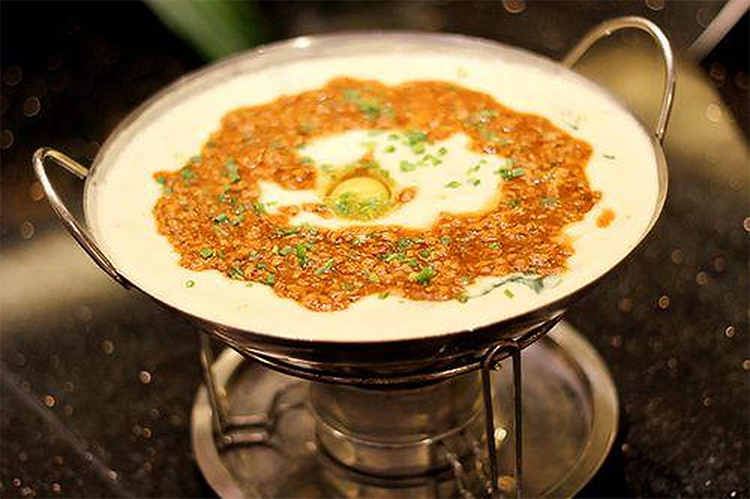He Zha (Lazy Tofu): Tujia Comfort Food from Xiangxi
Discover He Zha—known in English as “lazy tofu”—a humble yet soulful Tujia dish from Hunan’s Xiangxi region. Simple in appearance but rich in history and flavor, He Zha embodies rural resourcefulness and warm hospitality. For travelers who seek authentic Chinese food and cultural stories, a steaming bowl of He Zha is a must-try.
1. Origins and History: Mountain Wisdom in a Bowl
He Zha’s roots lie in the mountain villages of the Tujia people in Xiangxi. Centuries of living in rugged terrain shaped a cuisine built on thrift and seasonality. Instead of making refined tofu—which requires filtering and pressing—Tujia cooks left the whole soybean slurry intact, boiling it with local greens. This practical approach preserved nutrients and minimized waste, creating a nourishing staple that has been passed down through generations.
2. Cultural Significance: Food as Welcome and Respect
In Tujia households, He Zha is more than daily fare—it’s a symbol of hospitality. Serving He Zha to guests expresses acceptance and warmth. During festivals or when welcoming visitors, hosts often bring a bubbling pot of He Zha to the table—an invitation to share not just food, but trust. Local sayings even highlight its role in celebrations, as He Zha appears alongside other dishes during important gatherings, showing its deep cultural meaning.
3. Ingredients: Simple, Local, and Nutritious
The ingredient list is straightforward: high-quality yellow soybeans and seasonally available leafy greens—traditionally young pumpkin leaves, but also cabbage greens, radish greens, or spinach. In Xiangxi, soybeans benefit from favorable climate conditions that produce plump, aromatic beans. Seasonings are minimal—salt, garlic, and a spoonful of chili paste or fresh chilies—so the natural flavors of soybean and vegetables shine through.

4. Traditional Preparation: Hands-On, Low-Tech Craft
Don’t be fooled by the name “lazy tofu”—the dish reflects careful, time-honored craftsmanship. Soybeans are soaked overnight, then ground into a coarse slurry using a stone mill or blender. Crucially, the slurry is not strained—the soy pulp stays in. The mixture is simmered slowly with chopped greens, stirred constantly to prevent sticking. Once the greens have softened and the flavors meld, salt and chili are added. The result is a thick, fragrant, porridge-like pot of He Zha.
5. Flavor and Texture: Earthy, Comforting, Layered
He Zha’s texture is uniquely comforting: silky and creamy from the soybean slurry, yet slightly gritty from the retained pulp. First comes a rich, toasty bean aroma; then the fresh, slightly bitter note of pumpkin or cabbage leaves balances the richness. Chili adds a gentle zing that lifts the dish. It’s not about refinement—He Zha’s charm lies in its honesty, warmth, and deeply satisfying simplicity.
6. How It’s Eaten: Rustic Pairings and Local Rituals
In Xiangxi, He Zha is often served hot in a shared clay pot and poured over steamed white rice. The rice absorbs the savory broth, making every bite soothing and hearty. He Zha also pairs beautifully with smoky cured meats or pickled fish—the clean, vegetal flavors cut through richer foods. Eating it communally deepens the sense of sharing that’s central to Tujia hospitality.
7. Tasting Tips for Travelers: Finding Authentic He Zha
To taste the most authentic He Zha, head to Tujia villages in Xiangxi—areas like Yongshun and Longshan are known for genuine farmhouse cooking. Look for a slightly green-tinted, thick broth with a rich soybean aroma. Ask for “He Zha” or “Lan Doufu” (lazy tofu) and request mild spice if you prefer less heat. For an immersive experience, stay at a family-run guesthouse—hosts may even invite you to watch or join the cooking.

8. Practical Travel Tips: Language, Portions, and Etiquette
Say the name clearly—He Zha (pronounced “Huh Jah”) or Lan Doufu—to be understood. He Zha is typically served by the pot and meant for sharing; order a small pot for two if you’re traveling solo. If you can’t handle much chili, say “bu la” (not spicy) or “wei la” (mild). Many rural inns offer a hands-on demonstration—stirring the pot or grinding the soybeans yourself is a memorable cultural exchange.
9. Quick Home Version: Make He Zha Easily Anywhere
You can recreate a simple version of He Zha at home with a blender:
Ingredients:
100 g dried yellow soybeans (soaked 8 hours), a handful of spinach or pumpkin leaves, 1 clove garlic (minced), 1 teaspoon chili sauce, salt to taste
Method:
Blend soaked soybeans with water into a coarse slurry (do not strain). Simmer the slurry in a pot, stirring to avoid sticking. After 10 minutes, add chopped greens and cook until tender. Season with garlic, chili, and salt. Serve hot over rice.
This easy version keeps the essence of He Zha—nutritious, simple, and deeply comforting.

10. Conclusion: A Taste of Xiangxi Hospitality
He Zha is more than a regional dish—it’s a glimpse into Tujia life: frugal, creative, and full of heart. Whether you discover it in a mountain guesthouse in Hunan or try it at home, He Zha offers an authentic taste of Xiangxi that connects food, history, and community. Add it to your China travel list for a quietly unforgettable culinary experience.


